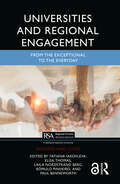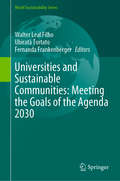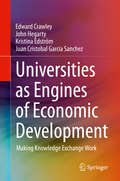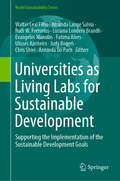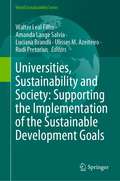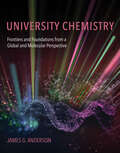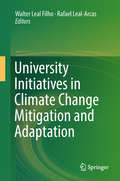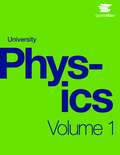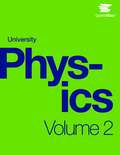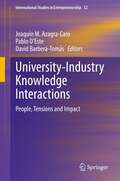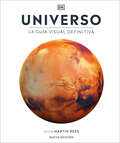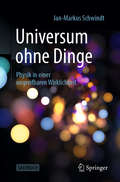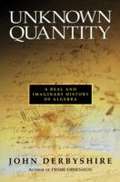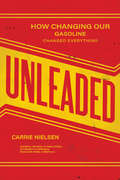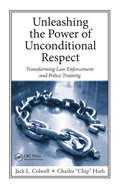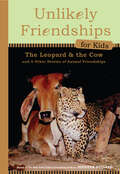- Table View
- List View
Universities and Regional Engagement: From the Exceptional to the Everyday (Regions and Cities)
by Rómulo Pinheiro Paul Benneworth Tatiana Iakovleva Elisa Thomas Laila Nordstrand BergThe study of universities’ role in regional engagement has traditionally been focusing on exceptional cases. This book presents a reconceptualision which embraces its underlying complexity, and proposes a roadmap for a renewed research agenda. Starting from the grassroots level of universities’ "everyday" engagements, the book delves into the manifold ways in which university knowledge agents build connections with regional partners. Through eleven empirical chapters, the authors not only chart the diversity amongst case institutions, engagement mechanisms and regional contexts, but also use that diversity to advance a novel conceptual framework for unpacking university-regions’ everyday activities, taking into account the dynamic, complex and co-evolving interplay between (a) key social agents and institutions, (b) the contexts in which they are embedded, as well as (c) the historical trajectories and strategic ambitions underpinning context-specific social- arrangements and interactions that are mediated by temporal and spatial dimensions. Drawing on evolutionary economic geography, innovation studies, management and organisation studies, and historical perspectives, the volume advances a new mode of understanding university-regional engagement as a form of extendable temporary coupling, which also helps to address perennial policy and managerial questions alike of what to do with universities that do not serve local labour market needs, and/or are located in regions suffering from brain drain. The book illustrates such dynamics from diverse national contexts: Brazil, Caribbean, China, Italy, Norway, and Poland. This book will be valuable reading for advanced students, researchers and policy makers working in economic geography, regional development, innovation and higher education management.
Universities and Sustainable Communities: Meeting the Goals of the Agenda 2030 (World Sustainability Series)
by Walter Leal Filho Fernanda Frankenberger Ubiratã TortatoThe book showcases examples of university engagement in community initiatives and reports on the results from research and from a variety of institutional projects and programmes. As a whole, the book illustrates how actors at the community (microlevel) and other levels (meso and macro) can make valuable and concrete contributions to the implementation of the Sustainable Development Goals (SDGs) and, more specifically, to achieving the objectives defined at the 2030 Agenda for Sustainable Development. It is one of the outcomes of the “Second World Symposium on Sustainability Science”, which was jointly organised by the Pontifícia Universidade Católica do Paraná (Brazil), the Research and Transfer Centre “Sustainable Development and Climate Change Management” and the “European School of Sustainability Science and Research” at Hamburg University of Applied Sciences (Germany), in cooperation with the Inter-University Sustainable Development Research Programme (IUSDRP).
Universities as Engines of Economic Development: Making Knowledge Exchange Work
by John Hegarty Kristina Edström Edward Crawley Juan Cristobal Garcia SanchezThis book describes patterns of behavior that collectively allow universities to exchange knowledge more effectively with industry, accelerate innovation and eventually contribute to economic development. These are based on the effective practices of leading and ambitious universities around the world that the authors have benchmarked, and the personal experiences of the authors in a number of international institution building projects, including those of MIT.The authors provide guidance that is globally applicable, but must be locally adapted. The approach is first to describe the context in which universities act as engines of economic development, and then present a set of effective practices in four domains: education, research, innovation, and supporting practices. Each of these domains has three to six practices, and each practice is presented in a similar template, with an abstract, a rationale and description, key actions and one or two mini-case studies. The practices are summarized by integrative case studies. The book:Focuses on a globally adaptable set of effective practices, complemented by case studies, that can enhance universities’ contribution to economic development, based on an integrated view of education, research and innovation;Presents effective practices and broader insights that come from real global experience, spelled out in templates and explained by cases;Includes tangible resources for university leaders, policy makers and funders on how to proceed.
Universities as Living Labs for Sustainable Development: Supporting the Implementation of the Sustainable Development Goals (World Sustainability Series)
by Walter Leal Filho Judy Rogers Chris Shiel Evangelos Manolas Ulisses Azeiteiro Amanda Lange Salvia Rudi W. Pretorius Luciana Londero Brandli Fatima Alves Arminda Do PacoThis book fills an important gap in the literature, and presents contributions from scientists and researchers working in the field of sustainable development who have engaged in dynamic approaches to implementing sustainability in higher education. It is widely known that universities are key players in terms of the implementation and further development of sustainability, with some having the potential of acting as “living labs” in this rapidly growing field. Yet there are virtually no publications that explore the living labs concept as it relates to sustainability, and in an integrated manner. The aims of this book, which is an outcome of the “4th World Symposium on Sustainable Development at Universities” (WSSD-U-2018), held in Malaysia in 2018, are as follows: i. to document the experiences of universities from all around the world in curriculum innovation, research, activities and practical projects as they relate to sustainable development at the university level; ii. to disseminate information, ideas and experiences acquired in the execution of projects, including successful initiatives and good practice; iii. to introduce and discuss methodological approaches and projects that seek to integrate the topic of sustainable development in the curricula of universities; and iv. to promote the scalability of existing and future models from universities as living labs for sustainable development. The papers are innovative, cross-cutting and many reflect practice-based experiences, some of which may be replicable elsewhere. Also, this book, prepared by the Inter-University Sustainable Development Research Programme (IUSDRP) and the World Sustainable Development Research and Transfer Centre (WSD-RTC), reinforces the role played by universities as living labs for sustainable development.
Universities, Sustainability and Society: Supporting the Implementation of the Sustainable Development Goals (World Sustainability Series)
by Walter Leal Filho Luciana Brandli Ulisses M. Azeiteiro Rudi Pretorius Amanda Lange SalviaIn order to yield the expected benefits, sustainability initiatives need to be undertaken by means of a close cooperation between universities on the one hand, and societal partners on the others. The principle of co-creation and co-execution of sustainability initiatives increases the value for all by mutual learning, and the sharing of expertise and resources. But pursuing sustainability initiatives with a community and societal involvement is not simple. There is a perceived need for a better understanding of how universities can interact with society, in order to support the implementation of the UN Sustainable Development Goals. This book is an attempt to address this need, by a novel approach which focuses on current potentials and challenges, across a wide range of fields and expertise. The book focuses on how the theory and practice of sustainable development interact and shows the need for a continuation of the dialogue among sustainability academics and practitioners, so as to address the issues, matters and problems at hand. The spectrum of themes addressed on this book also entails how environmental values and ethics are applied and the relationship between social, biological and cultural diversity. It also includes a broad disciplinary approach to sustainability, including education, research and case studies, and the links with human–environment relations in a sustainable development context.
University Chemistry: Frontiers and Foundations from a Global and Molecular Perspective
by James G. AndersonA new approach to teaching university-level chemistry that links core concepts of chemistry and physical science to current global challenges.Introductory chemistry and physics are generally taught at the university level as isolated subjects, divorced from any compelling context. Moreover, the &“formalism first&” teaching approach presents students with disembodied knowledge, abstract and learned by rote. By contrast, this textbook presents a new approach to teaching university-level chemistry that links core concepts of chemistry and physical science to current global challenges. It provides the rigorous development of the principles of chemistry but places these core concepts in a global context to engage developments in technology, energy production and distribution, the irreversible nature of climate change, and national security. Each chapter opens with a &“Framework&” section that establishes the topic&’s connection to emerging challenges. Next, the &“Core&” section addresses concepts including the first and second law of thermodynamics, entropy, Gibbs free energy, equilibria, acid-base reactions, electrochemistry, quantum mechanics, molecular bonding, kinetics, and nuclear. Finally, the &“Case Studies&” section explicitly links the scientific principles to an array of global issues. These case studies are designed to build quantitative reasoning skills, supply the technology background, and illustrate the critical global need for the infusion of technology into energy generation. The text&’s rigorous development of both context and scientific principles equips students for advanced classes as well as future involvement in scientific and societal arenas. University Chemistry was written for a widely adopted course created and taught by the author at Harvard.
University Initiatives in Climate Change Mitigation and Adaptation
by Walter Leal Filho Rafael Leal-ArcasThis book focuses on the role of higher education institutions in addressing climate change mitigation and adaptation challenges, contributing to the development of this fast-growing field. Further, it includes the results of empirical research and offers ideas regarding on-going and future research initiatives. The contributions also• showcase the research and projects on issues pertaining to climate change at universities from across the globe;• document and promote ideas and experiences acquired in the execution of research projects, especially successful initiatives and best practices; and• introduce methodological approaches and projects that offer a better understanding of climate change across society and economic sectors.The book is structured around two parts: lessons learned from climate change research, education, studies and projects. Each part focuses on mitigation and adaptation respectively, with many responses of the two modalities overlapping.This book is a valuable resource for researchers and practitioners in the fields of environment, human geography, business and economics, as well as academics and students, as it presents education, communication and awareness-raising projects on matters related to climate change at universities in both industrialised and developing countries, often in cooperation with government bodies, NGOs and other stakeholders.
University Physics
by Wolfgang Bauer Gary D. WestfallUniversity Physics is intended for use in the calculus-based introductory physics sequence at universities and colleges. It can be used in either a two-semester introductory sequence or a three-semester sequence. The course is intended for students majoring in the biological sciences, the physical sciences, mathematics, and engineering.
University Physics (Tenth Edition)
by Young Roger A. Freedman T. R. Sandin A. Lewis FordNow in its commemorative Tenth Edition, this book remains a classic. Adhering to the highest standards of integrity and incorporating some of the findings of current research in physics, it enables readers to develop physical intuition and build strong problem-solving skills. It also points out conceptual and computational pitfalls that commonly plague beginning physics students and provides them with explicit strategies for analyzing physical situations and solving problems.
University Physics (Volume 1) (13th Edition)
by Roger A. Freedman Hugh D. YoungUniversity Physics with Modern Physics, continues to set the benchmark for clarity and rigor combined with effective teaching and research-based innovation. University Physics is known for its uniquely broad, deep, and thoughtful set of worked examples--key tools for developing both physical understanding and problem-solving skills. The Thirteenth Edition revises all the Examples and Problem-Solving Strategies to be more concise and direct while maintaining the Twelfth Edition's consistent, structured approach and strong focus on modeling as well as math. To help students tackle challenging as well as routine problems, the Thirteenth Edition adds Bridging Problems to each chapter, which pose a difficult, multiconcept problem and provide a skeleton solution guide in the form of questions and hints. The text's rich problem sets--developed and refined over six decades--are upgraded to include larger numbers of problems that are biomedically oriented or require calculus. The problem-set revision is driven by detailed student-performance data gathered nationally through MasteringPhysics®, making it possible to fine-tune the reliability, effectiveness, and difficulty of individual problems. Complementing the clear and accessible text, the figures use a simple graphic style that focuses on the physics. They also incorporate explanatory annotations--a technique demonstrated to enhance learning. The above ISBN is just for the standalone book only Chapters 1-20, if you want the Book(only Chapters 1-20/Access Code please order: ISBN: 0321785916 / 9780321785916 University Physics Volume 1(Chapters 1-20 only ) and MasteringPhysics® with Pearson eText Student Access Code Card Package consists of: 032173338X / 9780321733382 University Physics Volume 1 (Chs. 1-20 only) 0321741269 / 9780321741264 MasteringPhysics® with Pearson eText Student Access Code Card for University Physics If you want the complete book order ISBN 0321696867 9780321696861 University Physics with Modern Physics, 13/e -- or valuepack 0321675460 / 9780321675460 University Physics with Modern Physics with MasteringPhysics® Package consists of 0321696867 / 9780321696861 University Physics with Modern Physics(complete book) 0321741269 / 9780321741264 MasteringPhysics® with Pearson eText Student Access Code Card for University Physics (ME component )
University Physics Volume 1
by Samuel J. Ling Jeff Sanny William MoebsUniversity Physics is a three-volume collection that meets the scope and sequence requirements for two- and three-semester calculus-based physics courses. Volume 1 covers mechanics, sound, oscillations, and waves. Volume 2 covers thermodynamics, electricity and magnetism, and Volume 3 covers optics and modern physics. This textbook emphasizes connections between theory and application, making physics concepts interesting and accessible to students while maintaining the mathematical rigor inherent in the subject. Frequent, strong examples focus on how to approach a problem, how to work with the equations, and how to check and generalize the result.
University Physics Volume 2: Atoms First
by Samuel J. Ling Jeff Sanny William MoebbsUniversity Physics is a three-volume collection that meets the scope and sequence requirements for two- and three-semester calculus-based physics courses. Volume 1 covers mechanics, sound, oscillations, and waves. Volume 2 covers thermodynamics, electricity and magnetism, and Volume 3 covers optics and modern physics. This textbook emphasizes connections between theory and application, making physics concepts interesting and accessible to students while maintaining the mathematical rigor inherent in the subject. Frequent, strong examples focus on how to approach a problem, how to work with the equations, and how to check and generalize the result.
University Physics: Technology Update, Volume 2
by Roger A. Freedman A. Lewis Ford Hugh D. YoungUniversity Physics with Modern Physics, Technology Update, Thirteenth Edition continues to set the benchmark for clarity and rigor combined with effective teaching and research-based innovation. Volume 2 is Chapters 21 to 37.
University-Industry Knowledge Interactions: People, Tensions and Impact (International Studies in Entrepreneurship #52)
by Joaquín M. Azagra-Caro Pablo D’Este David Barberá-TomásUniversity-industry interaction combines several layers of actors, states and effects. People make choices, based on their individual characteristics, at different stages of a scientific career, in a highly internationalised profession. Tensions arise when university administrators and managers need to strike a balance among different promotion instruments, or when the university or public research organisation tries to solve the trade-offs between long- and short-term relationships, or among new management practices. Impacts are related to scientific agendas, the economic returns for firms or the societal benefits. This book adopts a people-tension-impact approach to identify key insights, by combining qualitative and quantitative research, established and novel methodologies, and different geographic settings. The chapters in this volume provide new perspectives on university-industry interactions related to gender biases, entrepreneurial involvement of PhD students and the role of international mobility. They also focus on how the positive impacts of university-industry interactions coexist with unresolved tensions linked to policy combinations, long-term contractual relationships, management practices and organisational strategies.Chapters 4 and 6 are available open access under a Creative Commons Attribution 4.0 International License via link.springer.com.
Universo: La guía visual definitiva (DK Definitive Visual Encyclopedias)
by DKDéjate deslumbrar por las maravillas del universo a través de impresionantes imágenes y prepárate para conocer todo lo que necesitas saber sobre el cosmos.Universo es una enciclopedia llena de impactantes fotografías, información contrastada y explicaciones claras que te ayudarán comprender de manera fácil y visual todo lo relativo al universo y a los elementos y cuerpos que lo forman, como las estrellas, los planetas, los agujeros negros o las nebulosas. Esta enciclopedia del espacio, incluye: Impresionantes imágenes en 3D, mapas astrales y fotografías de calidad (¡entre ellas la primera que se tomó de un agujero negro!).Los últimos descubrimientos en astronomía, como las ondas gravitacionales, el agua líquida en Marte o nuevos planetas.Datos e información detallada de cada una de las constelaciones del firmamento.Un mapa que muestra cómo se ve el cielo de noche en cada mes del año desde los hemisferios norte y sur.Con explicaciones de los conceptos básicos de la astronomía, un análisis del Sistema Solar y las galaxias, y una guía del cielo nocturno, esta enciclopedia escrita por expertos en cosmología es el regalo perfecto para los amantes de esta ciencia. Marvel at the wonders of the universe, from stars and planets to black holes and nebulae, in this exploration of our solar system and beyond.Universe opens with a look at astronomy and the history of the Universe, using 3D artworks to provide a comprehensive grounding in the fundamental concepts of astronomy, including the basic techniques of practical astronomy.The core of the book is a tour of the cosmos covering the Solar System, the Milky Way, and galaxies beyond our own. Explanatory pages introduce different celestial phenomena, such as galaxies, and are followed by catalogs that profile the most interesting and important examples.A comprehensive star atlas completes the picture, with entries on each of the 88 constellations and a monthly sky guide showing the night sky as it appears throughout the year as viewed from both the northern and southern hemispheres
Universum ohne Dinge: Physik in einer ungreifbaren Wirklichkeit
by Jan-Markus SchwindtDie Physik ist in der Sprache der Mathematik geschrieben, und ihre Erkenntnisse beruhen auf Tausenden von Experimenten. Doch was für ein Bild zeichnet die Physik von der Welt? Was tragen Theorien wie die Relativitätstheorie oder die Quantenmechanik dazu bei? Wie vollständig ist dieses Bild? Dieses Buch beleuchtet, wie sich die „Dinge“, von denen diese Theorien handeln, zu unseren alltäglichen Dingen verhalten und zeigt auf, welche Fragen noch offen sind und welche Probleme damit einhergehen.Der Autor stellt in diesem Buch dar, wie Physik funktioniert, was sie leisten kann und was nicht. Dabei beschreibt er die überraschenden Antworten, die die Physik auf viele unserer Fragen nach der Natur der "Dinge" und der Welt gibt; Antworten, die unsere Intuition vor so manche Herausforderung stellen.
Unix and Perl to the Rescue!
by Ian Korf Keith BradnamYour research has generated gigabytes of data and now you need to analyse it. You hate using spreadsheets but it is all you know, so what else can you do? This book will transform how you work with large and complex data sets, teaching you powerful programming tools for slicing and dicing data to suit your needs. Written in a fun and accessible style, this step-by-step guide will inspire and inform non-programmers about the essential aspects of Unix and Perl. It shows how, with just a little programming knowledge, you can write programs that could save you hours, or even days. No prior experience is required and new concepts are introduced using numerous code examples that you can try out for yourself. Going beyond the basics, the authors touch upon many broader topics that will help those new to programming, including debugging and how to write in a good programming style.
Unknown Quantity: A Real And Imaginary History Of Algebra
by John DerbyshirePrime Obsession taught us not to be afraid to put the math in a math book. Unknown Quantity heeds the lesson well. So grab your graphing calculators, slip out the slide rules, and buckle up! John Derbyshire is introducing us to algebra through the ages—and it promises to be just what his die-hard fans have been waiting for.“Here is the story of algebra.” With this deceptively simple introduction, we begin our journey. Flanked by formulae, shadowed by roots and radicals, escorted by an expert who navigates unerringly on our behalf, we are guaranteed safe passage through even the most treacherous mathematical terrain. Our first encounter with algebraic arithmetic takes us back 38 centuries to the time of Abraham and Isaac, Jacob and Joseph, Ur and Haran, Sodom and Gomorrah. Moving deftly from Abel’s proof to the higher levels of abstraction developed by Galois, we are eventually introduced to what algebraists have been focusing on during the last century. As we travel through the ages, it becomes apparent that the invention of algebra was more than the start of a specific discipline of mathematics—it was also the birth of a new way of thinking that clarified both basic numeric concepts as well as our perception of the world around us. Algebraists broke new ground when they discarded the simple search for solutions to equations and concentrated instead on abstract groups. This dramatic shift in thinking revolutionized mathematics. Written for those among us who are unencumbered by a fear of formulae, Unknown Quantity delivers on its promise to present a history of algebra. Astonishing in its bold presentation of the math and graced with narrative authority, our journey through the world of algebra is at once intellectually satisfying and pleasantly challenging.
Unleaded: How Changing Our Gasoline Changed Everything
by Carrie NielsenWhen leaded gasoline was first developed in the 1920s, medical experts were quick to warn of the public health catastrophes it would cause. Yet government regulators did not heed their advice, and for more than half a century, nearly all cars used leaded gasoline, which contributed to a nationwide epidemic of lead poisoning. By the 1970s, 99.8% of American children had significantly elevated levels of lead in their blood. Unleaded tells the story of how crusading scientists and activists convinced the U.S. government to ban lead additives in gasoline. It also reveals how, for nearly fifty years, scientific experts paid by the oil and mining industries abused their authority to convince the public that leaded gasoline was perfectly harmless. Combining environmental history, sociology, and neuroscience, Carrie Nielsen explores how lead exposure affects the developing brains of children and is linked to social problems including academic failure, teen pregnancies, and violent crime. She also shows how, even after the nationwide outrage over Flint’s polluted water, many poor and minority communities and communities of color across the United States still have dangerously high lead levels. Unleaded vividly depicts the importance of sound science and strong environmental regulations to protect our nation’s most vulnerable populations.
Unleashed (Jinxed #2)
by Amy McCullochThe Golden Compass for the digital age in this action-packed sequel to Jinxed.When Lacey Chu wakes up in a hospital room with no memory of how she got there, she knows something went really wrong. And with her cat baku, Jinx, missing in action and MONCHA, the company behind the invention of the robot pet, threatening her family, she isn't sure who to turn to for answers.When Lacey is expelled and her mom starts acting strangely after the latest update from MONCHA, Lacey and her friends work together to get to the bottom of it and discover a sinister plot at the heart of the corporation.Lacey must use all her skills if she has a chance of stopping MONCHA from carrying out their plans. But can she take on the biggest tech company in North America armed with only a level 1 robot beetle and her friends at her side?Praise for Jinxed:"[A] vividly imagined Toronto-set middle grade series opener intertwines smartphone technology with the hallmarks of classic science fiction via a fun, insightful narrative and bright voice...With a sharp eye toward the rising awareness of device addiction and a keen sense of wonder, McCulloch's tale is a feast for the imagination that celebrates women in STEM fields."—Publishers Weekly (STARRED REVIEW)"McCulloch effectively strikes a balance between worldbuilding and action…A solid series starter for tinkerers and adventurers alike."—Kirkus Reviews"A little bit Golden Compass, a little bit Hunger Games, and all adventure!"—New York Times bestselling author Amie Kaufman
Unleashing Your Dog: A Field Guide to Giving Your Canine Companion the Best Life Possible
by Marc Bekoff Jessica PierceNo matter how cushy their lives, dogs live on our terms. They compromise their freedom and instinctual pleasure, as well as their innate strategies for coping with stress and anxiety, in exchange for the love, comfort, and care they get from us. But it is possible to let dogs be dogs without wreaking havoc on our lives, as biologist Marc Bekoff and bioethicist Jessica Pierce show in this fascinating book. They begin by illuminating the true nature of dogs and helping us &“walk in their paws.&” They reveal what smell, taste, touch, sight, and hearing mean to dogs and then guide readers through everyday ways of enhancing dogs&’ freedom in safe, mutually happy ways. The rewards, they show, are great for dog and human alike.
Unleashing the Power of Unconditional Respect: Transforming Law Enforcement and Police Training
by Jack Colwell Charles HuthEvery day, police officers face challenges ranging from petty annoyances to the risk of death in the line of duty. Coupled with these difficulties is, in some cases, lack of community respect for the officers despite the dangers these men and women confront while protecting the public. Exploring issues of courage, integrity, leadership, and charact
Unlikely Friendships for Kids: And Four Other Stories of Animal Friendships (Unlikely Friendships for Kids #1)
by Jennifer S. HollandGood friends come in all shapes and sizes!Unlikely Friendships, the runaway New York Times bestseller with a compelling message of hope and friendship and differences overcome, is rewritten just for younger readers. This hardcover chapter book for children ages seven and up collects five heartwarming true stories of animal friendship: a hippo and the goat who is his best friend, an iguana that snuggles with a cat, a dog that takes care of a blind deer, a cat and orangutan who become friends, and a mother dog who cares for a tiny piglet. Chapter books give young readers a strong sense of accomplishment, and these heartwarming animal stories, with their incredible photographs and inexplicable mysteries of attraction, their focus on friendship, love, and the ways that creatures of all different species can find common bonds of affection, will keep kids turning the pages to find out about the unusual ways animals help each other and discover the love of new friends. Each is a perfect gift for young animal lovers, and a lovely subject to help kids get reading.
Unlikely Friendships for Kids: And Four Other Stories of Animal Friendships (Unlikely Friendships for Kids #2)
by Jennifer S. HollandGood friends come in all shapes and sizes!Unlikely Friendships, the runaway New York Times bestseller with a compelling message of hope and friendship and differences overcome, is rewritten just for younger readers. This hardcover chapter book for children ages seven and up collects five heartwarming true stories of animal friendship: Koko the gorilla and her favorite kittens, a dog who swims with dolphins, a zebra who cares for a young gazelle, a baby warthog who makes friends with a lonely rhinoceros, and a leopard who cuddles with a cow at bedtime. Chapter books give young readers a strong sense of accomplishment, and these heartwarming animal stories, with their incredible photographs and inexplicable mysteries of attraction, their focus on friendship, love, and the ways that creatures of all different species can find common bonds of affection, will keep kids turning the pages to find out about the unusual ways animals help each other and discover the love of new friends. Each is a perfect gift for young animal lovers, and a lovely subject to help kids get reading.
Unlikely Friendships for Kids: And Four Other Stories of Animal Friendships (Unlikely Friendships for Kids #3)
by Jennifer S. HollandUnlikely Friendships is a phenomenon. It’s a runaway New York Times bestseller with more than 260,000 copies in print in less than half a year; a book with its compelling message of hope and friendship and differences overcome. Temple Grandin called it “. . . amazing. It shows the power of friendship.” Now Unlikely Friendships is rewritten for younger readers: Unlikely Friendships for Kids, a series of hardcover chapter books for children, ages seven and up. Here are three collections each with five of the clearest, most interesting stories from the original book, like the monkey and the dove or the leopard and the cow. Chapter books give young readers a strong sense of accomplishment, and these heartwarming animal stories, with their incredible photographs and inexplicable mysteries of attraction, their focus on friendship, love, and the ways that creatures of all different species can find common bonds of affection, will keep kids turning the pages to find out about the unusual ways animals help each other and discover the love of new friends.Each is a perfect gift for young animal lovers, and a lovely subject to help kids get reading.
